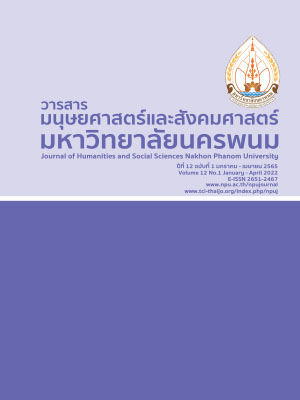การพัฒนาความฉลาดรู้ด้านวิทยาศาสตร์ เรื่อง กรด - เบส ด้วยการจัดการเรียนรู้ แบบใช้บริบทเป็นฐานร่วมกับการใช้เทคโนโลยี สำหรับนักเรียนชั้นมัธยมศึกษาปีที่ 5
Main Article Content
บทคัดย่อ
การวิจัยนี้เชิงปฏิบัติการในชั้นเรียนนี้มีวัตถุประสงค์เพื่อศึกษาแนวทางการจัดการเรียนรู้แบบใช้บริบทเป็นฐานร่วมกับการใช้เทคโนโลยีที่พัฒนาความฉลาดรู้ด้านวิทยาศาสตร์ และศึกษาพัฒนาการความฉลาดรู้ด้านวิทยาศาสตร์ เรื่อง กรด-เบส กลุ่มเป้าหมายในการวิจัย ได้แก่ นักเรียนชั้นมัธยมศึกษาปีที่ 5 จำนวน 22 คน เครื่องมือที่ใช้ในการวิจัยประกอบด้วย แผนการจัดการเรียนรู้แบบใช้บริบทเป็นฐานร่วมกับการใช้เทคโนโลยี แบบสะท้อนการจัดการเรียนรู้ ใบกิจกรรมของนักเรียนและแบบวัดความฉลาดรู้ด้านวิทยาศาสตร์ โดยวิเคราะห์ข้อมูลจากแบบสะท้อนการจัดการเรียนรู้ด้วยการวิเคราะห์เชิงเนื้อหา วิเคราะห์การพัฒนาระดับความฉลาดรู้ด้านวิทยาศาสตร์ด้วยการให้คะแนนและจัดระดับตามกรอบการประเมิน PISA 2015 และใช้วิธีการตรวจสอบแบบสามเส้าเพื่อยืนยันความน่าเชื่อถือของงานวิจัย ผลการวิจัยพบว่า แนวทางการจัดการเรียนรู้แบบใช้บริบทเป็นฐานร่วมกับการใช้เทคโนโลยีประกอบด้วย 4 ขั้น ได้แก่ ขั้นที่ 1 ขั้นกำหนดสถานการณ์ ครูกำหนดสถานการณ์เกี่ยวกับสิ่งแวดล้อมรอบตัวนักเรียนที่สามารถพบเห็นได้ในชีวิตประจำวันและใช้คำถามกระตุ้นให้นักเรียนระบุปัญหาและ เลือกประเด็นที่สามารถตรวจสอบได้ด้วยวิธีการทางวิทยาศาสตร์ ขั้นที่ 2 ขั้นลงมือปฏิบัติงาน ครูให้นักเรียนออกแบบวิธีการตรวจสอบปัญหาโดยบูรณาการร่วมกับการใช้แอพพลิเคชันหรือโปรแกรมห้องปฏิบัติการเสมือนและเครือข่ายสังคมออนไลน์ เพื่อให้นักเรียนได้ใช้เป็นเครื่องมือในการลงมือปฏิบัติหรือสืบค้นหาข้อมูลเพิ่มเติมหรือใช้เพื่อแลกเปลี่ยนความคิดเห็นและประเมินความเหมาะสมของวิธีการที่ได้ออกแบบไว้ขณะลงสำรวจพื้นที่จริง ขั้นที่ 3 ขั้นเรียนรู้แนวคิดสำคัญ นักเรียนวิเคราะห์ผลการตรวจสอบ อภิปรายและออกแบบผ่านเว็บไซต์สำหรับงานกราฟิกพร้อมนำเสนอผลการตรวจสอบและขั้นที่ 4 ขั้นนำไปใช้ในสถานการณ์ใหม่ ครูนำเสนอสถานการณ์ใหม่ที่คล้ายคลึงสถานการณ์เดิมผ่านเครือข่ายสังคมออนไลน์ สำหรับผลการพัฒนาความฉลาดรู้ด้านวิทยาศาสตร์ของนักเรียนพบว่า นักเรียนสามารถพัฒนาระดับความฉลาดรู้ด้านวิทยาศาสตร์หลังเรียนอยู่ที่ระดับ 2 สูงกว่าก่อนเรียนที่ระดับ 1b โดยสมรรถนะทางวิทยาศาสตร์ที่นักเรียนมีการพัฒนามากที่สุดไปน้อยที่สุด ได้แก่ สมรรถนะการแปลความหมายข้อมูลและการใช้ประจักษ์พยานในเชิงวิทยาศาสตร์ สมรรถนะการอธิบายปรากฏการณ์ในเชิงวิทยาศาสตร์และสมรรถนะการประเมินและออกแบบกระบวนการสืบเสาะหาความรู้ทางวิทยาศาสตร์
Article Details

This work is licensed under a Creative Commons Attribution-NonCommercial-NoDerivatives 4.0 International License.
References
Chanapimuk K. (2020). [Promoting Scientific Literacy by using Science, Technology, Society, and Environment (STSE) approach of Grade 11th Students on the Topic of Plant Growth]. Journal of Education Naresuan University, 22(2), 62-73.
Chindanurak T. (2017). khrū læ nakrīan nai yuk kānsưksā Thai 4.0 [Teachers and Students in Thailand Education 4.0]. Electronic Journal of Open and Distance Innovative Learning (e-JODIL)., 7(2), 14-29.
Damjub W. (2019). sư̄ sangkhom ʻō̜nlai kap kānrīanrū nai satawat thī yīsipʻet [Social Media for Teaching and Learning in the 21st Century]. Journal of Liberal Arts, Maejo University, 7(2), 143-159.
Davenport J., Rafferty A., and Yaron D. (2018). Whether and How Authentic Contexts Using a Virtual Chemistry Lab Support Learning. Journal of Chemical Education. 95(8), 1250-1259.
IPST. (2018). phonkān pramœ̄n PISA sō̜ngphansiphā witthayāsāt kān ʻān læ khanittasāt. [The result PISA 2018 Reading Mathematical and Science]. Bangkok: IPST.
IPST. (2021). phonkān pramœ̄n PISA sō̜ngphansippǣt kān ʻān khanittasāt læ witthayāsāt [The result PISA 2018 Reading Mathermatical and Science]. Bangkok: IPST.
National Science Technology and Innovation Policy Office. (2009). nayōbāi læ phǣn witthayāsāt theknōlōyī læ nawattakam hǣng chāt chabap thī nưng [National Science Technology and Innovation Policy No.1]. Bangkok; Ministry of Science and Technology.
Nimla-or P. (2017). phonkān chai nǣokhit kānrīanrū dōi chai bō̜ribot pen thān thī mī tō̜ khwāmkhaočhai manō that chīwawitthayā khō̜ng nakrīan matthayommasưksā tō̜n plāi [Effects of Using Contex-Based Learning Approach on Conceptual Understanding in Biology of Upper Secondary School Students]. An Online Journal of Education, 12(2), 224-238.
Oebsuksiri A. (2014). čhittawitthayā samrap khrū [Psychology for Teacher]. 2nd ed. Bangkok; Chulalongkorn University Press.
Overtoon, T. L., Byers B., and Seery, M. K. (2015). Context and Problem based Learning in Higher Level Chemistry Education: Innovation Methods of Teaching and Learning Chemistry in Higher Education. UK: RSC Publishing.
Pattiyatanee, S. (2017). kān watphon kānsưksā [Educational measurement]. 11th ed. Kalasin: Prasarnkarnpim.
Phabchai P. (2020). kānphatthanā kān rū witthayāsāt dōi chai kānčhatkān rīanrū thī chai bō̜ribot pen thān rư̄ang krot - bēt samrap nakrīan chan matthayommasưksā pī thī hā [Developing Scientific Literacy in the Topic of Acid-Base Using Context-Based Learning Management for Grade 11th Students]. Journal of Education Naresuan University, 22(3), 164-176.
Prins G., Bulte A., and Pilot A. (2018). Designing context-based teaching materials by transforming authentic scientific modelling practices in chemistry. International Journal of Science Education, 40(10), 1108-1135.
Reangrit N. (2017). ʻin fōkrāfik kap kānʻō̜kbǣp sư̄ kānsō̜n [Infographic and Instructional Design], Journal of Education, Silpakorn University, 15(2), 29-40
Sakulwichitsintu S. (2017). kānchai theknōlōyī sārasonthēt phư̄a kānrīanrū rūam kan thāng ʻō̜nlai [UsingInformation Technology for Online Collaborative Learning]. Veridian E-Journal, Silpakorn University (Humanities, Social Sciences and arts), 10(2), 437-450.
Srinarang W. (2019). theknōlōyī phư̄a kānrīanrū nai satawat thī yīsipʻet [Technology for Learning in the 21st Century]. IPST Magazine, 47(219), 26-29.
Watayotha K. (2019). khwāmkhit sāngsan khō̜ng phū rīan thī rīan dūai singwǣtlō̜m thāngkān rīanrū mantimīdīa rūam kap theknōlōyī samư̄an čhing tām nǣo khō̜n satraktiwit thī songsœ̄m khwāmkhit sāngsan rư̄ang kānsāng san chin ngān dūai krabūankān theknōlōyī samrap nakrīan chan matthayommasưksā pī thī sō̜ng [Creative Thinking of the Learners with Constructivist Multimedia Learning Environment and Augmented Reality to Promote Creative Thinking on the topic of Product Creation by Technological Process for Grade 8 Students]. Veridian E-Journal, Silpakorn University (Humanities, Social Sciences and arts), 12(2), 499-518.

